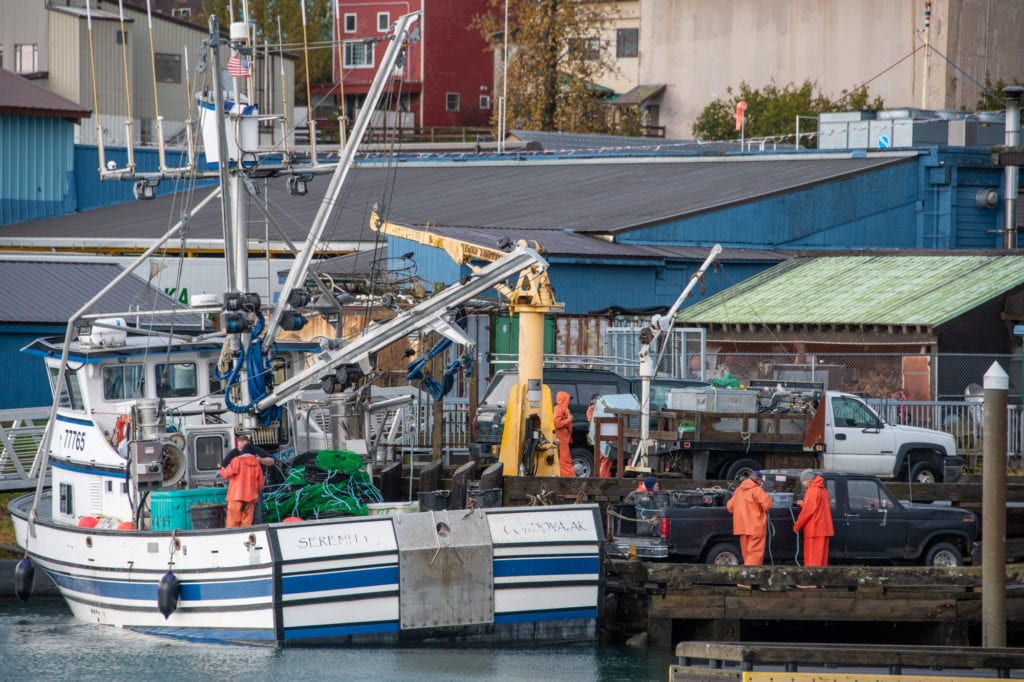
As Bob Dylan famously said “you don’t need a weatherman to know which way the wind blows.”
Particularly if you’re a juvenile Pollock in the Gulf of Alaska.
A newly released study from NOAA Fisheries’ Alaska Fisheries Science Center (AFSC) offers insight into the importance of wind to Pollock population dynamics in the Gulf.
The study conclusively shows for the first time that year-to-year variation in the geographic distribution of juvenile Pollock in the Gulf is driven by wind direction, which may keep juvenile Pollock in favorable habitat, or push them into currents and on to less favorable conditions.
Alaska Pollock spawn in the spring in Shelikof Strait. Their eggs and larvae drift southwestward, but where those young fish end up in late summer varies from year to year.
“Wind is the culprit,” according to AFSC biologist Matt Wilson. “The consequence is that when a large proportion of the juvenile population is transported to the southwest many of those fish are likely lost from the Gulf of Alaska.”
Winds interacting with the rotation of the earth move surface water at right angles to wind direction, a phenomenon known as the Coriolis effect. In the Gulf of Alaska, prevailing northeasterly winds move surface water toward the coast, where it is forced downward, driving the downwelling pattern that is typical of the region.
Wilson and co-author Ned Laman also found that the geographic distribution of juvenile Pollock was highly variable from year to year, and that wind is the culprit.
Alaska Pollock is the nation’s largest commercial fishery by volume and considered to be one of the best managed and most sustainable fisheries in the world. Management decisions are based on stock assessments and forecasts that incorporate a suite of environmental variables.
Wilson said this study provides new insight into the importance of wind to Pollock population dynamics. These findings argue for including wind-driven surface transport along with other important factors like temperature, prey and predation that have been used in stock forecast models, he said.
That first year of life is critical to young Pollock.
For those who survive, the mortality rate drops significantly after their first birthday. During that first year, Pollock are weak swimmers, who will drift where currents take them, and where they end up will determine whether or not they will contribute to the adult Gulf population.
Evidence of the influence of transport on Gulf Pollock year class success dates back to survey data collected from the 1980s. In 1987, NOAA’s Fisheries Oceanography Coordinated Investigations program repeatedly surveyed early life stages of Pollock in the western Gulf. That year a large cohort of Pollock was spawned in Shelikof Strait and within their first six months many members of that cohort were transported far to the southwest.
“That initially large cohort of juveniles didn’t recruit to be a particularly strong year class,” Wilson said. The following year the Pollock produced another large cohort of juveniles, but this time many remained in the Shelikof area and recruited into an abundant adult year class.
Still it wasn’t until 2013-2017 that a series of geographically extensive Gulf biennial surveys offered the opportunity to investigate relationships between wind, transport and year-class strength, researchers said.
The 2013 juvenile distribution was similar to that of 1987, in that an unusually large abundance of juveniles was found in the southwest. Then in 2015, juveniles were relatively evenly distributed, but that was associated with the marine heatwave known as “the Blob.”
In 2017 population densities were the highest in the Shelikof and Kodiak regions.
The Oceanography Coordinated Investigations program offered biologists plenty of information to determine the distribution of Pollock over a wide area, and collect data to conclusively address their questions, Wilson said.
While the prevailing winds are northeasterlies, northerly and westerly winds may intermittently drive surface water away from the coast. Cold water rises from lower depths to replace surface water in an upwelling pattern and as surface water moves offshore, it meets the southwestward flowing Alaskan Stream.
Wilson and Laman found that when downwelling-favorable winds prevailed during and after spawning, juveniles tended to stay in upsteam habitat near the main spawning area around Kodiak Island, an area with abundance of lipid-rich euphausiids or krill. Very young Pollock first eat a diet of small copepods, then graduate to large copepods, then krill and finally fish, so the availability of euphausiids during late summer in crucial.
Research biologist Jesse Lamb and zooplankton ecologist David Kimmer, also of the AFSC, found that there are large populations of large euphausiids around Kodiak Island and juvenile Pollock there are large, while in the southwest there are fewer, smaller euphausiids and smaller juvenile Pollock.
Wilson said there is a need to continue this kind of geographically extensive surveys to fully understand fine-scale mechanisms that link wind to how young fish re dispersed, to help solve future recruitment puzzles.
“Wind-driven transport is likely to change with climate,” he said. “Understanding how wind influences Pollock dynamics will be essential for us to anticipate and prepare for future changes.”





